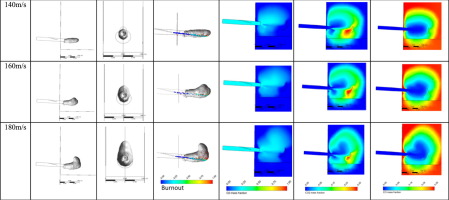Applied Energy ( IF 10.1 ) Pub Date : 2020-01-07 , DOI: 10.1016/j.apenergy.2019.114456 Yuting Zhuo , Yansong Shen

|
The blast furnace is a highly efficient but energy-intensive chemical reactor for iron production. Two types of solid fuels, viz. coarse coke particles and fine pulverized coal powders, are combusted simultaneously, forming the dynamic cavities (termed raceway) at the lower part of the blast furnace, and their behaviour affects each other considerably, although this has not been clearly established in the past. In this study, a three-dimensional transient model is developed for describing the complex co-combustion of pulverized coal and coke coupled with the dynamic raceway evolution under industrial-scale blast furnace conditions. The model couples a gas-coke combustion model with a gas-coal combustion model in a transient state by means of two-way coupling scheme. The model is then validated against experimental measurements. The typical transient in-furnace phenomena are illustrated in terms of raceway shape and size, gas-solid-powder flow, temperature fields, gas composition and coal and coke combustion. As time progresses from 0 s to 7.0 s, the raceway size increases in depth, width and height; and the coal burnout slightly increases. At around 7.0 s, the raceway profile and coal and coke combustion approach a relatively stable state. Additionally, the effects of blast rate on the in-furnace phenomena are studied. Under the simulated conditions, when the blast rate is increased from 140 m/s to 180 m/s, a larger raceway is formed and the depth is increased by 22.2%. Subsequently, the average burnout of pulverized coal is improved by 3.6% and the reducing gas, i.e., CO, is increased by 1%. This model offers a cost-effective tool to optimize coke/coal co-combustion in blast furnaces for energy saving and operation stability.
中文翻译:

炼铁高炉动态滚道中煤与焦炭共燃烧的三维瞬态模型
高炉是用于钢铁生产的高效但能源密集型化学反应器。两种固体燃料,即。粗焦炭颗粒和细粉煤粉同时燃烧,在高炉下部形成动态腔体(称为滚道),尽管过去还不清楚,但它们的行为会相互影响很大。在这项研究中,建立了一个三维瞬态模型,用于描述工业规模高炉条件下煤粉和焦炭的复杂共燃烧以及动态跑道的演变。该模型通过双向耦合方案将瞬态下的焦炭燃烧模型与气煤燃烧模型耦合。然后针对实验测量对模型进行验证。典型的瞬态炉内现象以滚道的形状和尺寸,气固粉末流动,温度场,气体成分以及煤和焦炭燃烧。随着时间从0秒增加到7.0秒,滚道的深度,宽度和高度会增加;燃煤量略有增加。在大约7.0 s处,滚道轮廓以及煤和焦炭燃烧接近一个相对稳定的状态。另外,研究了鼓风速率对炉内现象的影响。在模拟条件下,当爆破速度从140 m / s增加到180 m / s时,会形成更大的滚道,深度增加22.2%。随后,粉煤的平均燃尽提高了3.6%,还原气体(即CO)提高了1%。该模型提供了一种经济高效的工具,可优化高炉中的焦炭/煤共燃,从而节省能源并提高运行稳定性。滚道尺寸在深度,宽度和高度上都会增加;燃煤量略有增加。在大约7.0 s处,滚道轮廓以及煤和焦炭燃烧接近一个相对稳定的状态。另外,研究了鼓风速率对炉内现象的影响。在模拟条件下,当爆炸速率从140 m / s增加到180 m / s时,会形成较大的滚道,深度增加22.2%。随后,粉煤的平均燃尽提高了3.6%,还原气体(即CO)提高了1%。该模型提供了一种经济高效的工具,可优化高炉中的焦炭/煤共燃,从而节省能源并提高运行稳定性。滚道尺寸在深度,宽度和高度上都会增加;燃煤量略有增加。在大约7.0 s处,滚道轮廓以及煤和焦炭燃烧接近一个相对稳定的状态。另外,研究了鼓风速率对炉内现象的影响。在模拟条件下,当爆破速度从140 m / s增加到180 m / s时,会形成更大的滚道,深度增加22.2%。随后,粉煤的平均燃尽提高了3.6%,还原气体(即CO)提高了1%。该模型提供了一种经济高效的工具,可优化高炉中的焦炭/煤共燃,从而节省能源并提高运行稳定性。滚道轮廓以及煤和焦炭燃烧都处于相对稳定的状态。另外,研究了鼓风速率对炉内现象的影响。在模拟条件下,当爆破速度从140 m / s增加到180 m / s时,会形成更大的滚道,深度增加22.2%。随后,粉煤的平均燃尽提高了3.6%,还原气体(即CO)提高了1%。该模型提供了一种经济高效的工具,可优化高炉中的焦炭/煤共燃,从而节省能源并提高运行稳定性。滚道轮廓以及煤和焦炭燃烧都处于相对稳定的状态。另外,研究了鼓风速率对炉内现象的影响。在模拟条件下,当爆破速度从140 m / s增加到180 m / s时,会形成更大的滚道,深度增加22.2%。随后,粉煤的平均燃尽提高了3.6%,还原气体(即CO)提高了1%。该模型提供了一种经济高效的工具,可优化高炉中的焦炭/煤共燃,从而节省能源并提高运行稳定性。煤粉的平均燃尽提高了3.6%,还原气(CO)提高了1%。该模型提供了一种经济高效的工具,可优化高炉中的焦炭/煤共燃,从而节省能源并提高运行稳定性。煤粉的平均燃尽提高了3.6%,还原气(CO)提高了1%。该模型提供了一种经济高效的工具,可优化高炉中的焦炭/煤共燃,从而节省能源并提高运行稳定性。











































 京公网安备 11010802027423号
京公网安备 11010802027423号